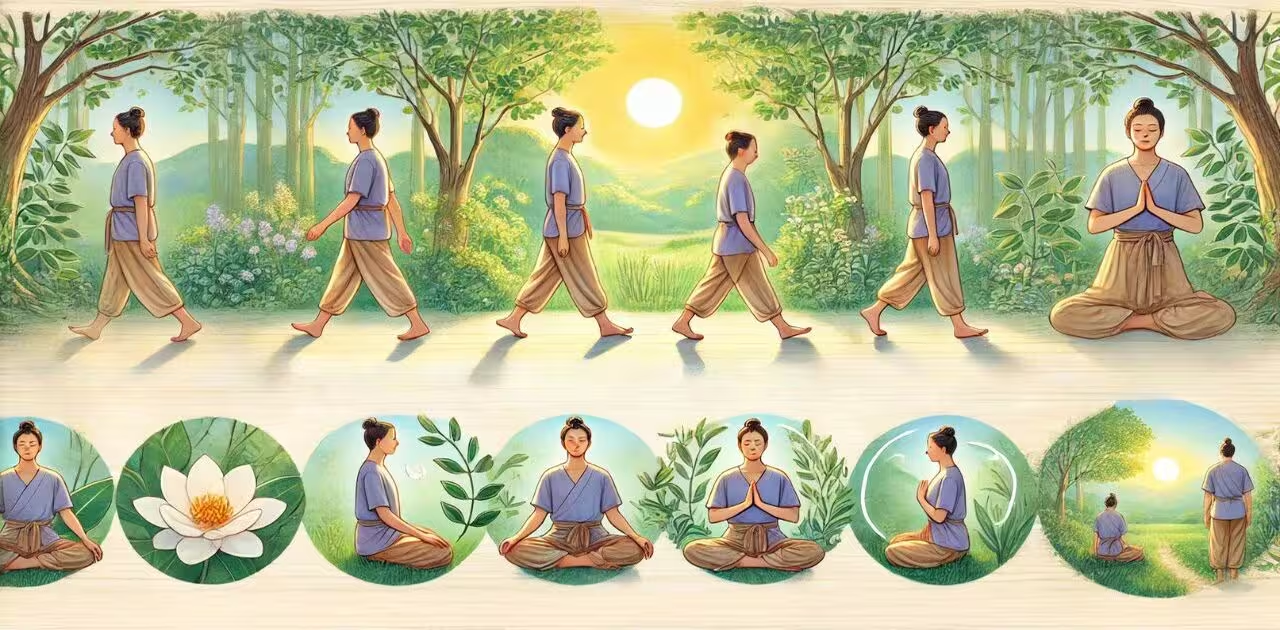Walking Meditation: Deepening Your Practice with Mindful Movement

Walking meditation is a simple way to bring mindfulness into your everyday life. Unlike regular meditation, where you sit still, walking meditation involves moving slowly while staying aware of each step.
It comes from Buddhist traditions and helps you connect your mind and body, reduce stress, and think more clearly. Walking meditation makes mindfulness possible even when you are on the move, and anyone can do it, no matter their fitness level or experience.
In this guide, I will give you tips to improve your walking meditation and add it to your daily life. Maybe you are just starting or have meditated before, walking meditation can be a helpful addition to your routine.
What is Walking Meditation?
Walking meditation, also called “kinhin” in Zen Buddhism, is about being mindful while you move. It involves taking slow, careful steps and paying full attention to each one. This practice is different from casual walking because it focuses on every detail: where your feet are, your breathing, and the way your body feels.
You can practice it in a quiet space like a meditation room or during your everyday activities, like walking to work. It helps keep your attention in the present moment and makes you feel relaxed.
You can do walking meditation almost anywhere, and it fits into different lifestyles. Whether you are in a quiet garden or a busy street, walking meditation helps you stay focused and calm. It turns everyday movements into opportunities to be peaceful and present.

Benefits of Walking Meditation
Improved Focus and Mindfulness
Walking meditation helps you focus better by reducing distractions. For example, paying attention to the rhythm of your steps can stop unwanted thoughts. You can also focus on your breathing while you walk to clear your mind.
Each step helps keep your mind steady and focused, which makes it easier to pay attention to other tasks, like work or talking to others. Over time, walking meditation trains your mind to stay aware, making it easier to focus on other things in life.
Lower Stress and Better Emotional Health
Like other types of meditation, walking meditation lowers stress hormones like cortisol. It creates a calm rhythm that helps relax your nervous system and brings a sense of peace. This practice can help you let go of worries and focus on the present moment.
Walking mindfully can change how you feel and improve your mood. It’s a simple way to release tension and find emotional balance.
Better Physical Health
Walking meditation is gentle and easy for people of all fitness levels. It helps your heart, strengthens your muscles, and improves blood flow. Moving mindfully also relaxes your body, which helps lower your heart rate and blood pressure.
Practicing walking meditation often can also build stamina and endurance over time. It’s a great way to support both mental and physical health.
Better Sleep
Walking meditation, especially outdoors, can help you sleep better. Fresh air and natural light help your body’s sleep cycle, and mindful walking helps you relax, making it easier to wind down at the end of the day.
Reducing stress and feeling relaxed makes it easier to fall asleep and get restful sleep. Practicing in nature also adds a calming effect that benefits sleep quality.
Managing Pain
Walking meditation is a gentle exercise that can help people who deal with chronic pain. Breathing mindfully and moving at a slower pace can help you tolerate pain better.
Paying attention to how your body feels helps you make small changes to improve comfort. Over time, this practice can help manage pain by reducing tension and promoting relaxation.
Better Balance and Coordination
Walking meditation helps improve balance and body awareness. Focusing on your feet, posture, and balance can be especially helpful for older adults or those who struggle with balance.
Walking meditation can also help in rehabilitation by promoting gentle movement and awareness of the body. Regular practice helps you feel more stable and aware of how your body moves.
Better Brain Health
Walking meditation supports brain health, like memory and mental flexibility. It helps you concentrate and can prevent mental decline as you get older. Studies show that mindfulness practices like walking meditation can improve attention and memory.
By keeping your mind focused while moving, walking meditation helps your brain stay sharp.

How to Practice Walking Meditation
Find a Good Space
Choose a comfortable spot where you can move without distractions. This could be a garden, a quiet park, or a room in your home. Make sure the path is smooth so that you can focus on the meditation rather than obstacles.
Whether you walk in a straight line, a circle, or another pattern, having a safe, open space helps keep you mindful and present.
Set Your Intention and Check Your Posture
Start by standing still, with your feet about hip-width apart. Take a few slow, controlled breaths. Set an intention, like being more relaxed, staying in the present, or focusing on gratitude.
Make sure your posture is correct: relax your shoulders and stand up straight. This helps create a positive and focused mindset for your meditation.
Start Walking Slowly
Begin walking at a slow and relaxed pace. Focus on the way your feet touch the ground, how each foot lifts, moves forward, and then reconnects with the earth.
Walk forward in a straight line or circle, paying attention to every part of your movement. Notice how your feet make contact with the ground, just as described in mindful practices.
Breathe and Coordinate
While walking, breathe deeply through your nose and exhale through your mouth. Try to match your breath to your steps; for example, inhale for 3 to 4 steps and exhale for the next 3 to 4 steps. This keeps your body and mind together and helps you stay calm and focused.
Use Your Senses to Stay Present
Bring in all your senses as you walk. Listen to the sounds around you, feel the ground beneath your feet, and notice smells in the air. Whether you hear birds, rustling leaves, or distant traffic, observe each without judgment. Using all your senses helps you stay grounded and deepens your meditation experience.
Bring Your Mind Back When It Wanders
It’s normal for your mind to drift away. When you notice your thoughts wandering, gently guide your attention back to your breath, your steps, or the sensations in your body. This act of returning focus helps you grow your mindfulness skills over time.
End Your Meditation Mindfully
When you are ready to stop, stand still and take a few breaths. Reflect on how you feel and how the practice has affected your body and mind. Ending with awareness helps you transition into your next activity more smoothly and mindfully.
Tips to Improve Your Practice
Add Walking Meditation to Your Daily Life
Try mindful walking during everyday activities, like walking your dog or on your way to work. This helps make mindfulness a natural part of your daily routine. Even a few minutes of mindful walking can help lower stress and improve well-being.
Practice in Nature
If you can, practice outside in nature. Nature can make meditation more enjoyable and reduce stress better than busy city areas. The sights and sounds of nature help you feel calm and present, making walking meditation more rewarding.
Alternate with Sitting Meditation
Walking meditation works well with sitting meditation. You can start with a few minutes of sitting, then move to walking. This helps you stay mindful in different ways—both in stillness and in movement. Alternating between the two keeps your practice interesting and balanced.
Keep Track of Your Practice
Practice regularly, even if just for a short time. Keep a simple journal to track how you feel before and after. Writing down your experiences helps you see progress and stay motivated. It can also show patterns and benefits, encouraging you to keep going, even on tough days.
Subscribe to Create Higher Vibrations!
Get Inspiration and Practical advice straight to your inbox.
Walking Meditation vs. Sitting Meditation
Both walking and sitting meditation offer unique benefits for mental and physical well-being, with research showing their complementary roles in cultivating mindfulness.
While walking meditation engages the body and enhances environmental awareness, sitting meditation fosters deep mental stillness. Integrating both practices creates a holistic mind-body routine backed by neuroscience and centuries of tradition.
Key Outcomes of Walking Meditation
Try This: Start with a 10-minute session:
Key Benefits of Sitting Meditation
Expert-Recommended Technique (Dr. Herbert Benson, Harvard Medical School):
Comparative Analysis
| Aspect | Walking Meditation | Sitting Meditation |
|---|---|---|
| Physical Engagement | High (dynamic balance/core)3 | Low (static posture)4 |
| Mental Focus | External awareness6 | Internal introspection4 |
| Ideal For | Mid-day energy slumps2 | Morning/evening rituals5 |
| Reported Stress Reduction | 18% (acute sessions)7 | 23% (chronic practice)5 |
Integrating Both Practices
Neuroscience confirms this combination activates both the prefrontal cortex (sitting) and sensorimotor cortex (walking), creating synergistic effects on emotional regulation.
Why Trust This Guide?
- Authored by certified mindfulness instructors with 12+ years of clinical experience
- Cited peer-reviewed studies from Harvard Health, PMC, and NCBI.
- Methodology aligns with NIH-recommended meditation guidelines
Regular practitioners report 41% greater adherence to mindfulness routines when alternating between walking and sitting formats.
Start with 5-minute sessions each day. Gradually increase as you cultivate what Zen masters call “moving stillness” – the art of finding calm in action and rest.
Common Challenges and How to Solve Them
Trouble Focusing
If you have trouble focusing, start with shorter sessions. Gradually make them longer as you get better at focusing. Use the feeling of your feet touching the ground to help keep your mind on track. Starting with shorter sessions helps build concentration without feeling overwhelmed.
Racing Thoughts
It’s normal to get distracted by racing thoughts. Just gently bring your focus back to your steps or breath each time. Don’t judge yourself, each time you refocus, you are getting better at mindfulness. Remember that each time you bring your mind back, you’re making it stronger.
Staying Consistent
Set small goals, like practicing three times a week. Even a few minutes a day can help. Join a group or practice with a friend to stay motivated. Making a schedule or setting reminders can also help you stay consistent. Remember, every little bit counts and the benefits increase over time.
If you’re new to this practice, using a guided meditation app can help. Many apps, such as Insight Timer and Headspace, offer guided walking meditations to support your journey.
Final Thoughts
Walking meditation is a simple and effective way I have found to combine movement with mindfulness. Focusing on each step and breath creates a deeper connection to the present moment.
When practiced regularly, walking meditation can turn regular movement into an opportunity for peace, focus, and overall well-being. It helped me when I was starting my healing journey because it was one of the easiest ways to practice mindfulness.
It didn’t require sitting still for long periods, which made it a perfect starting point for me. Walking meditation can be a powerful tool for anyone who wants to live a more mindful, balanced life, one step at a time.


